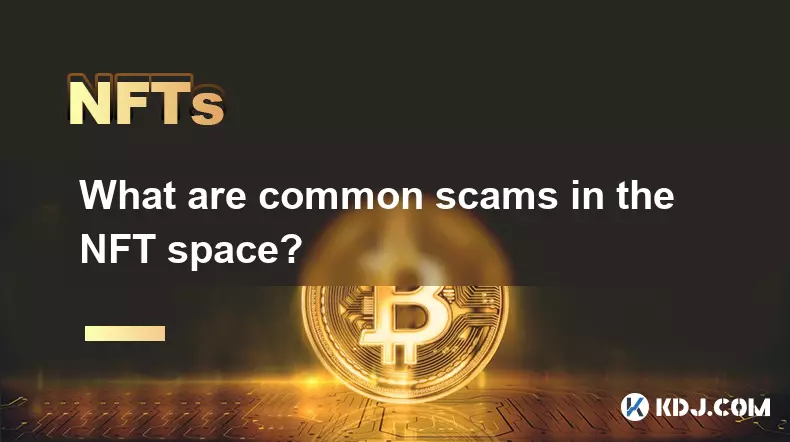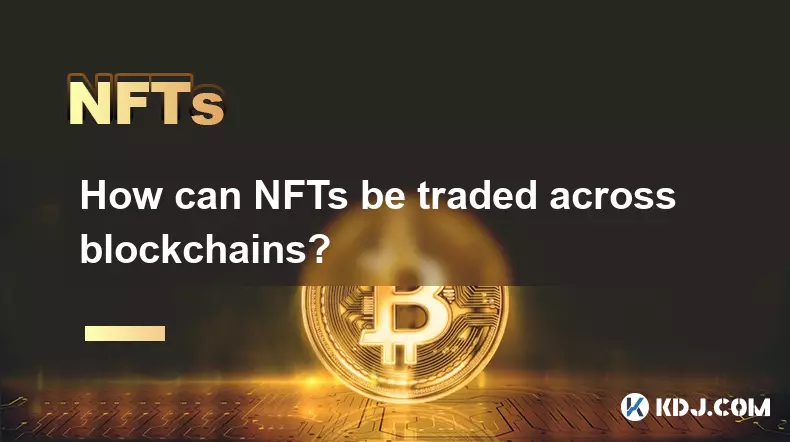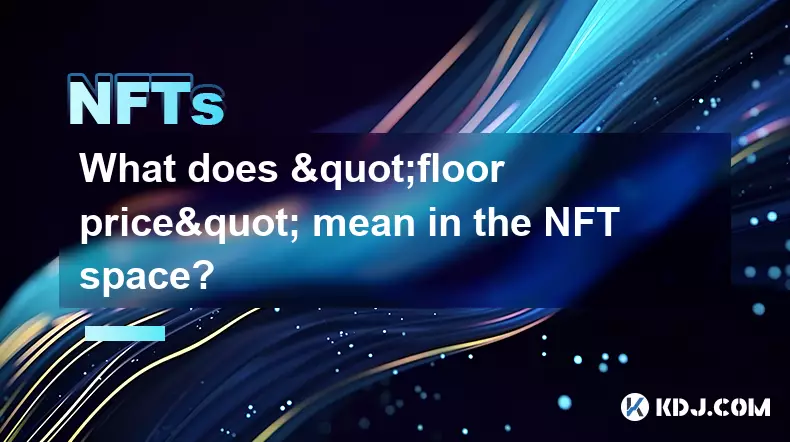-
 bitcoin
bitcoin $109667.069529 USD
-3.03% -
 ethereum
ethereum $3936.685804 USD
-4.07% -
 tether
tether $1.000493 USD
0.01% -
 xrp
xrp $2.771823 USD
-4.74% -
 bnb
bnb $957.805027 USD
-5.34% -
 solana
solana $196.735100 USD
-6.68% -
 usd-coin
usd-coin $0.999727 USD
-0.01% -
 dogecoin
dogecoin $0.227355 USD
-5.12% -
 tron
tron $0.335205 USD
-0.81% -
 cardano
cardano $0.779256 USD
-3.59% -
 ethena-usde
ethena-usde $0.999900 USD
-0.06% -
 hyperliquid
hyperliquid $42.492095 USD
-6.61% -
 chainlink
chainlink $20.501853 USD
-4.34% -
 avalanche
avalanche $28.952606 USD
-11.21% -
 stellar
stellar $0.356038 USD
-3.93%
What are common scams in the NFT space?
Scammers target NFT holders with fake marketplaces, phishing links, and spoofed listings—always verify URLs, wallet addresses, and project legitimacy to protect your assets.
Sep 22, 2025 at 02:54 am

Phishing Attacks Targeting NFT Holders
1. Scammers often create fake websites that mimic legitimate NFT marketplaces such as OpenSea or Rarible. These sites are designed to look identical to the real ones, tricking users into entering their wallet credentials. Once logged in, attackers gain full access to the victim’s digital assets.
2. Phishing emails and direct messages on social platforms are commonly used to lure NFT collectors. These messages may claim there is a bidding opportunity or an urgent security alert, prompting the user to click on a malicious link.
3. Some phishing attempts use QR codes that redirect users to compromised interfaces. When scanned, these codes automatically connect to a fraudulent site where private keys can be exposed.
Victims of phishing often lose entire wallets, including rare NFTs and cryptocurrency balances, with no chance of recovery.Fake NFT Projects and Rug Pulls
1. Fraudulent creators launch NFT collections with elaborate roadmaps, celebrity endorsements, and promises of future utility. After generating hype and selling out the mint, the team disappears, leaving buyers with worthless tokens.
2. These projects often use manipulated Discord and Twitter metrics to appear legitimate. Bots inflate follower counts and engagement, creating a false sense of community trust.
3. In many rug pulls, liquidity is drained from decentralized exchanges shortly after launch. The native token tied to the NFT ecosystem crashes to zero, rendering staking or reward mechanisms useless.
Investors who rely solely on social media buzz without verifying project teams or code audits are especially vulnerable.Spoofed Listings and Price Manipulation
1. On peer-to-peer marketplaces, scammers list extremely valuable NFTs at drastically reduced prices. Unsuspecting buyers rush to purchase, only to realize the listing was a typo or a scam account mimicking a verified seller.
2. Another tactic involves using similar-looking wallet addresses to confuse users. A buyer might send funds to a nearly identical address, thinking it belongs to the genuine seller.
3. Some attackers exploit auction systems by placing high bids with unconfirmed transactions. This tricks others into overbidding, believing the item is in high demand.
Always verify wallet addresses manually and double-check transaction details before confirming any purchase.Counterfeit NFTs and Plagiarized Art
1. Artists frequently discover their work has been uploaded and sold as NFTs without permission. These unauthorized mints replicate popular illustrations, photographs, or digital designs across multiple platforms.
2. Buyers may unknowingly purchase counterfeit NFTs, believing they are supporting original creators. Reselling such assets can lead to disputes or delisting by marketplaces upon detection.
3. Some scammers use AI-generated images passed off as limited editions. These pieces lack provenance and artistic value, yet are marketed aggressively through paid promotions.
Due diligence, including reverse image searches and verification of creator profiles, is essential before acquiring any NFT.How can I identify a fake NFT marketplace?
Check the URL carefully for misspellings or slight variations from the official domain. Legitimate platforms use HTTPS and often display security badges. Look for verified social media links and audit reports published by reputable firms. Avoid sites that require immediate wallet connection upon landing.
What should I do if I sent funds to a scammer?
Immediately disconnect your wallet from all websites using browser extension settings. Report the transaction hash to blockchain analysis tools like Chainalysis or TRM Labs. While recovery is unlikely, documenting the incident helps track patterns and warn others. Never share your seed phrase with anyone claiming they can retrieve lost assets.
Can stolen NFTs be recovered?
Recovery depends on the platform and jurisdiction. Some marketplaces allow freezing of reported stolen tokens if action is taken quickly. Law enforcement agencies rarely intervene due to the pseudonymous nature of blockchains. Prevention through secure practices remains the most effective strategy.
Are free NFT airdrops safe?
Not always. Free mints can carry hidden smart contract risks, such as granting approval to drain other tokens in your wallet. Only claim airdrops from known, trusted projects. Review contract permissions and revoke unnecessary approvals using tools like Revoke.cash.
Disclaimer:info@kdj.com
The information provided is not trading advice. kdj.com does not assume any responsibility for any investments made based on the information provided in this article. Cryptocurrencies are highly volatile and it is highly recommended that you invest with caution after thorough research!
If you believe that the content used on this website infringes your copyright, please contact us immediately (info@kdj.com) and we will delete it promptly.
- XRP Price: October Rally on the Horizon After September Consolidation?
- 2025-09-26 16:25:13
- Bitcoin Price Wobbles: Investors Buy the Dip as Powell's Words Stir Uncertainty
- 2025-09-26 16:25:13
- Kaspa Price, Smart Contracts, and the 2026 Forecast: A New York Minute
- 2025-09-26 16:30:01
- Bitwise, Hyperliquid ETF, and HYPE Token: What's the Deal?
- 2025-09-26 16:45:14
- B HODL, Bitcoin, and Treasury Purchases: The New Institutional Playbook
- 2025-09-26 17:05:15
- Cloudflare, Stablecoins, and AI Agents: A New Era of Automated Finance
- 2025-09-26 16:45:14
Related knowledge

How can I determine the authenticity of an NFT project?
Sep 23,2025 at 05:18pm
Understanding the Project Team and Their Background1. Research the identities of the team members behind the NFT project. Verified social media profil...

What's the difference between NFTs and traditional collectibles?
Sep 19,2025 at 12:55pm
Digital Ownership and Provenance1. NFTs are built on blockchain technology, which ensures transparent and immutable records of ownership. Every transa...

How can NFTs be traded across blockchains?
Sep 19,2025 at 12:00pm
Understanding Cross-Chain NFT Trading1. Non-fungible tokens (NFTs) are digital assets that represent ownership of unique items on a blockchain. Origin...

How is NFT rarity calculated?
Sep 18,2025 at 07:54pm
Understanding NFT Rarity Metrics1. NFT rarity is determined by analyzing the uniqueness of individual traits within a collection. Each NFT typically c...

What does "floor price" mean in the NFT space?
Sep 22,2025 at 06:36am
Floor Price: A Core Metric in the NFT Marketplace1. The term floor price refers to the lowest current asking price for any item within a specific NFT ...

How do NFTs help content creators?
Sep 18,2025 at 08:00am
NFTs Empower Creators with Ownership and Monetization1. NFTs provide content creators with verifiable ownership of their digital works, ensuring authe...

How can I determine the authenticity of an NFT project?
Sep 23,2025 at 05:18pm
Understanding the Project Team and Their Background1. Research the identities of the team members behind the NFT project. Verified social media profil...

What's the difference between NFTs and traditional collectibles?
Sep 19,2025 at 12:55pm
Digital Ownership and Provenance1. NFTs are built on blockchain technology, which ensures transparent and immutable records of ownership. Every transa...

How can NFTs be traded across blockchains?
Sep 19,2025 at 12:00pm
Understanding Cross-Chain NFT Trading1. Non-fungible tokens (NFTs) are digital assets that represent ownership of unique items on a blockchain. Origin...

How is NFT rarity calculated?
Sep 18,2025 at 07:54pm
Understanding NFT Rarity Metrics1. NFT rarity is determined by analyzing the uniqueness of individual traits within a collection. Each NFT typically c...

What does "floor price" mean in the NFT space?
Sep 22,2025 at 06:36am
Floor Price: A Core Metric in the NFT Marketplace1. The term floor price refers to the lowest current asking price for any item within a specific NFT ...

How do NFTs help content creators?
Sep 18,2025 at 08:00am
NFTs Empower Creators with Ownership and Monetization1. NFTs provide content creators with verifiable ownership of their digital works, ensuring authe...
See all articles










































































